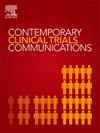Operating characteristics of unequal allocation ratios in platform trials with the staggered addition of drugs using binary endpoints
IF 1.4
Q4 MEDICINE, RESEARCH & EXPERIMENTAL
引用次数: 0
Abstract
Background
One recommendation for the allocation ratio between multiple drugs and a shared placebo control group in platform trials (PTs) is to use a :1 allocation ratio for the placebo group relative to the drug group, where is the number of drug groups with ongoing patient enrollment during the trials. However, the practical utility of such unequal allocation ratios in PTs lacks adequate study.
Methods
We compared the performances of equal and unequal allocation ratios through simulations to imitate practical PTs using only concurrent controls and binary endpoints for hospitalized patients with infectious diseases. The operating characteristics, including the type I error rate, power of hypothesis testing, and total sample size, were evaluated.
Results
In PTs, using an unequal allocation ratio (i) results in a considerable augmentation of the total sample size and prolongs the study duration when monthly patient enrollment is low, but (ii) the target power of hypothesis testing is often preserved compared to an equal allocation ratio, even when we incorrectly specify the drug and placebo group mortality rates assumed in the sample size calculation. The average power increase using an unequal allocation ratio relative to the equal allocation ratio per 100-patient increase in the placebo group was approximately 1.9 % in the selected scenarios of our simulation studies.
Conclusion
The results of the current study highlight the quantitative advantages and disadvantages of using unequal allocation ratios in PTs using only concurrent controls under the specific conditions assumed in our simulations and analyses.
使用双终点交错添加药物的平台试验中不平等分配比例的运行特征
背景:对于平台试验(PTs)中多种药物和共享安慰剂对照组之间的分配比例,推荐使用安慰剂组相对于药物组的k:1分配比例,其中k为试验期间持续入组患者的药物组数量。然而,这种不平等分配比例在PTs中的实际效用缺乏充分的研究。方法通过模拟传染病住院患者的实际PTs,采用并行对照和双终点,比较等分配比例和不等分配比例的效果。评估了操作特征,包括I型错误率、假设检验能力和总样本量。结果在PTs中,使用不平等分配比例(i)会导致总样本量的显著增加,并在每月患者入组率较低时延长研究时间,但(ii)即使我们在样本量计算中错误地指定了药物组和安慰剂组的死亡率,与平均分配比例相比,假设检验的目标功率通常仍然保留。在我们模拟研究的选定情景中,使用不平等分配比例的平均功率增加相对于安慰剂组每增加100例患者的平均功率增加约为1.9%。结论本研究的结果突出了在我们的模拟和分析中假设的特定条件下,在仅使用并发对照的PTs中使用不平等分配比例的定量优势和劣势。
本文章由计算机程序翻译,如有差异,请以英文原文为准。
求助全文
约1分钟内获得全文
求助全文
来源期刊

Contemporary Clinical Trials Communications
Pharmacology, Toxicology and Pharmaceutics-Pharmacology
CiteScore
2.70
自引率
6.70%
发文量
146
审稿时长
20 weeks
期刊介绍:
Contemporary Clinical Trials Communications is an international peer reviewed open access journal that publishes articles pertaining to all aspects of clinical trials, including, but not limited to, design, conduct, analysis, regulation and ethics. Manuscripts submitted should appeal to a readership drawn from a wide range of disciplines including medicine, life science, pharmaceutical science, biostatistics, epidemiology, computer science, management science, behavioral science, and bioethics. Contemporary Clinical Trials Communications is unique in that it is outside the confines of disease specifications, and it strives to increase the transparency of medical research and reduce publication bias by publishing scientifically valid original research findings irrespective of their perceived importance, significance or impact. Both randomized and non-randomized trials are within the scope of the Journal. Some common topics include trial design rationale and methods, operational methodologies and challenges, and positive and negative trial results. In addition to original research, the Journal also welcomes other types of communications including, but are not limited to, methodology reviews, perspectives and discussions. Through timely dissemination of advances in clinical trials, the goal of Contemporary Clinical Trials Communications is to serve as a platform to enhance the communication and collaboration within the global clinical trials community that ultimately advances this field of research for the benefit of patients.
 求助内容:
求助内容: 应助结果提醒方式:
应助结果提醒方式:


